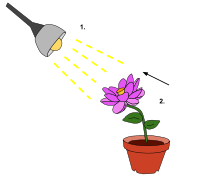
Back Stimulus Afrikaans Reiz ALS منبه (علم وظائف الأعضاء) Arabic Estímulu AST Stimul Azerbaijani Стымул Byelorussian Дразнимост Bulgarian Estímul Catalan وریاکەرەوە (فیزیۆلۆجی) CKB Stimulace Czech

| Part of a series on |
| Biology |
|---|
 |
In physiology, a stimulus[1] is a change in a living thing's internal or external environment. This change can be detected by an organism or organ using sensitivity, and leads to a physiological reaction.[2] Sensory receptors can receive stimuli from outside the body, as in touch receptors found in the skin or light receptors in the eye, as well as from inside the body, as in chemoreceptors and mechanoreceptors. When a stimulus is detected by a sensory receptor, it can elicit a reflex via stimulus transduction. An internal stimulus is often the first component of a homeostatic control system. External stimuli are capable of producing systemic responses throughout the body, as in the fight-or-flight response. In order for a stimulus to be detected with high probability, its level of strength must exceed the absolute threshold; if a signal does reach threshold, the information is transmitted to the central nervous system (CNS), where it is integrated and a decision on how to react is made. Although stimuli commonly cause the body to respond, it is the CNS that finally determines whether a signal causes a reaction or not.
- ^ Prescriptivist's Corner: Foreign Plurals Archived 17 May 2019 at the Wayback Machine: "Biologists use stimuli, but stimuluses is in general use."
- ^ "Excitability – Latest research and news | Nature". www.nature.com. Archived from the original on 5 November 2021. Retrieved 8 August 2021.